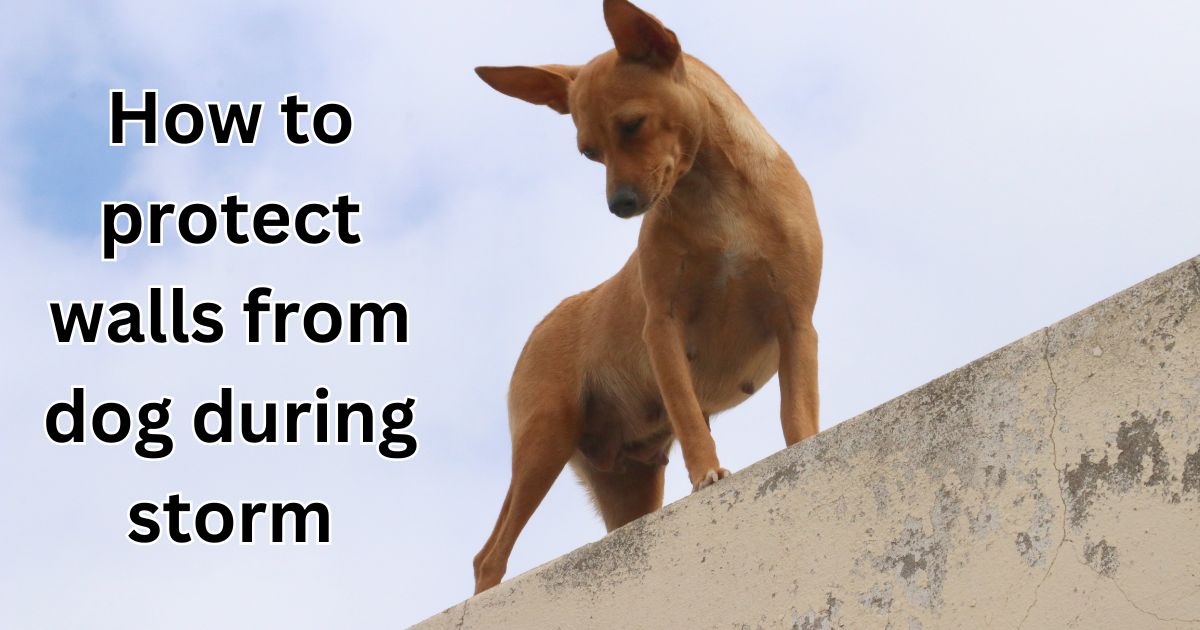When storms strike, they bring with them a host of challenges, not just for humans but also for our furry friends. Dogs, especially those with storm anxiety, can exhibit destructive behaviors that may lead to significant damage to your home. Understanding how to protect walls from dog during storm is crucial for maintaining a safe and clean living environment. Pets often react to storms with fear and panic, which can manifest in behaviors such as scratching, chewing, or bumping into walls. Addressing these issues requires a multifaceted approach involving preparation, training, and protective measures.
Storms can lead to unpredictable behavior in dogs, and while we might focus on safeguarding our homes, it’s equally important to ensure our pets feel secure. This article will explore various strategies to prevent damage to your walls, ensuring both your home and your dog remain safe during storms.
Understanding the Impact of Storms on Dogs
Behavioral Changes in Dogs During Storms
Dogs can become profoundly unsettled during storms due to the loud noises, flashing lights, and shifts in atmospheric pressure. These stimuli can trigger severe anxiety, leading to destructive behaviors such as scratching walls, chewing on furniture, or even attempting to escape. Understanding these behavioral changes is the first step in mitigating potential damage.
Storms can exacerbate pre-existing anxieties or trigger new ones. Dogs might try to find a safe spot by clawing at walls or creating a mess in their attempts to seek refuge. This frantic behavior is driven by their inability to understand the cause of their distress, making it essential for pet owners to address these fears proactively.
Physical Impact on the Home
The physical impact on your home can be significant if your dog becomes agitated during a storm. Common damage includes scratched walls, chewed corners, and dislodged wall coverings. This type of damage not only affects the aesthetic value of your home but can also lead to more severe structural issues if left unaddressed.
For instance, scratched walls can compromise paint and wallpaper, leading to more extensive repairs. In extreme cases, anxious dogs might even cause structural damage by trying to dig or scratch through walls. Addressing these issues promptly and effectively can prevent costly repairs and ensure that your home remains in good condition.
Preparing Your Home for a Storm
Creating a Safe Space for Your Dog
Creating a secure and comfortable area for your dog is crucial in minimizing storm-related anxiety. A designated space should be equipped with a cozy bed, toys, and familiar items to help your dog feel safe. Crates can be particularly effective as they provide a sense of security and can be lined with soft bedding to make them inviting.
Ensure this safe space is in a quiet area of your home, away from windows and doors where storm sounds are most intense. Adding a cover or a calming blanket to the crate can provide an extra layer of comfort. This preparation helps reduce stress and prevents your dog from seeking solace in destructive behaviors.
Securing the Interior
Reinforcing your home’s interior can also play a significant role in preventing damage. Using protective barriers or coverings can shield walls from scratches and other potential damage. Removable covers, such as vinyl or fabric panels, can be installed temporarily during storms to protect vulnerable areas.
In addition, consider using pet-friendly wall guards that can absorb impact and prevent scratches. These solutions are particularly useful in high-traffic areas where your dog might be most active. Securing the interior not only protects your walls but also helps maintain a clean and damage-free environment.
Also Read: Great Western Buildings Complaints
Training Your Dog to Cope with Storms
Desensitization Techniques
Desensitizing your dog to storm-like conditions is an effective method for reducing anxiety. Start by exposing your dog to recorded storm sounds at a low volume and gradually increase the intensity over time. This gradual exposure helps your dog become accustomed to the sounds without overwhelming them.
Pair these sessions with positive reinforcement, such as treats or praise, to create a positive association with the storm sounds. This technique can reduce your dog’s overall anxiety and prevent destructive behavior during actual storms. Consistency and patience are key, as desensitization is a gradual process that requires time.
Behavioral Training
In addition to desensitization, teaching your dog specific commands can help manage anxiety during storms. Commands like “sit,” “stay,” or “calm” can redirect your dog’s focus and provide a sense of control. Behavioral training should be done with the guidance of a professional trainer if necessary, especially if your dog exhibits severe anxiety. Training should also include creating a routine that helps your dog understand that storms are not a threat. Regular practice of commands and calming exercises can improve your dog’s ability to cope with storm-related stress. This approach is a key component in understanding how to protect walls from dog during storm by reducing the likelihood of destructive behaviors. Engaging with a professional trainer can offer additional strategies tailored to your dog’s needs, ensuring that both your home and your pet are well-prepared for stormy weather.
Protective Measures for Your Walls
Using Wall Protectors
Installing wall protectors is a practical way to safeguard your walls from potential damage. Various types of wall protectors are available, including removable covers and padded panels. These protectors are designed to absorb impacts and prevent scratches, making them ideal for high-risk areas.
When selecting wall protectors, consider options that are easy to install and remove. Removable covers can be especially useful for temporary protection during storms. Ensure that the protectors are securely attached and cover all vulnerable areas to provide comprehensive protection.
Applying Protective Coatings
Protective coatings can also be applied to walls to prevent damage. These coatings create a durable barrier that can withstand scratches and impacts. Products such as washable paint or protective varnishes offer added protection and are easy to clean.
Applying these coatings involves preparing the wall surface, applying the protective layer, and allowing it to dry thoroughly. This process helps create a resilient surface that can endure the impacts caused by anxious dogs. Regular maintenance and reapplication of coatings may be necessary to ensure continued protection.
Storm-Proofing Your Home
Reinforcing Wall Structures
Reinforcing your wall structures can provide long-term protection against storm damage. Methods such as adding extra layers of drywall or installing impact-resistant panels can strengthen your walls and make them more resilient to scratches and impacts.
Regular inspections and maintenance of your home’s walls are essential for identifying any weaknesses. Addressing these issues proactively can prevent more severe damage and ensure that your home remains secure during storms. Investing in reinforcement measures can be particularly beneficial in storm-prone areas.
Choosing Durable Materials
Selecting durable materials for your walls can significantly impact their ability to withstand storm damage. Materials such as impact-resistant drywall or reinforced concrete offer greater protection compared to traditional wall materials.
When building or renovating, consider materials that are designed to handle extreme conditions. Comparing different options and consulting with construction professionals can help you choose the best materials for your specific needs. Durable materials not only protect your walls but also contribute to the overall safety and longevity of your home.
Emergency Preparedness
Creating a Storm Plan
Having a storm plan in place is crucial for both your safety and your dog’s well-being. A comprehensive plan should include steps to take before, during, and after a storm. Preparing an emergency kit with essentials such as food, water, medications, and first aid supplies for your dog is essential.
Your plan should also outline how to secure your home and protect your walls. This includes identifying safe areas, reinforcing structures, and having protective measures in place. Regularly reviewing and updating your storm plan ensures that you are prepared for any situation.
Contacting Professionals
In some cases, consulting with professionals may be necessary. If your home suffers significant damage during a storm, a contractor can assess and repair structural issues. Additionally, if your dog’s anxiety becomes severe, a veterinarian or animal behaviorist can offer specialized advice and treatment options.
Finding the right professionals involves researching local experts and seeking recommendations from trusted sources. Timely intervention can prevent further damage and address any issues related to your dog’s storm anxiety.
Case Studies
Real-Life Examples
Examining real-life examples of pet owners who successfully protected their homes can provide valuable insights. Stories of individuals who implemented effective measures to safeguard their walls and manage their dogs’ anxiety offer practical advice and inspiration.
Lessons learned from these cases highlight the importance of preparation and proactive measures. By sharing these experiences, you can gain a better understanding of how to apply similar strategies in your own home.
Conclusion
In summary, how to protect walls from dog during storm involves a combination of preparation, training, and protective measures. Creating a safe space for your dog, reinforcing your home’s interior, and using protective coatings are all essential steps in maintaining both your home’s integrity and your dog’s well-being.
Additional resources and tools for storm preparedness and pet care are available to further assist you. Staying informed and proactive can make a significant difference in how effectively you protect your home and your pet during storms. Encourage a proactive approach and continue to seek out new strategies and solutions for storm preparedness.










